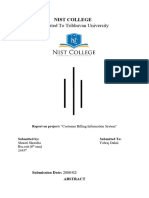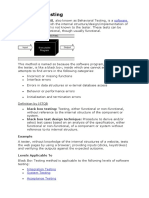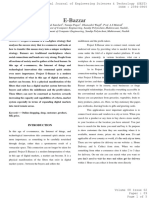Python Project
Uploaded by
Hamada SaiedPython Project
Uploaded by
Hamada SaiedExpense Tracker
We have daily expenses, from groceries to clothing to bills. There are so many
expenses that it’s normal to lose track of them and keep spending till we’re
almost out of cash. A tracker can help people watch their expenses.
This is where the expense tracker comes in. An expense tracker is a software
tool that allows users to keep track of their expenses. It can also analyze the
expenses, depending on how advanced it is, but let’s keep it simple for now.
With the expense tracker, users can set a budget and track their spending so
as to make better financial decisions.
Examples of Expense Trackers
Here are some implementations of the Expense Tracker idea:
Buddi
GnuCash
Technical Details
The main objective of this project is to keep track of the user’s expenses. Some
statistical analysis has to be done to be able to give users correct information
on their expenses and help them spend better.
While tracking the expenses is the key thing, a good interface is also
important. With PySimpleGUI, you can create a unique interface to improve the
experience of the users.
PyData libraries such as pandas and matplotlib can be helpful for building the
expense tracker.
The pandas library can be used for the data analysis, and the matplotlib library
can be used for plotting graphs. Graphs will give the users a visual
representation of their expenses, and a visual representation is usually easier
to understand.
The application will receive data from the users. The data here is the inputted
expenses. So, you’ll have to store the expenses in a database. The SQLite
database is a good database choice for this project since it can be set up
quickly. You can use sqlite3 module for the SQLite database.
You might also like
- Project Report On Daily Expense Tracking SystemNo ratings yetProject Report On Daily Expense Tracking System37 pages
- Optimizing Information Leakage in Multicloud Storage Services67% (3)Optimizing Information Leakage in Multicloud Storage Services27 pages
- Agile Software Development: 5.1 Coping With ChangeNo ratings yetAgile Software Development: 5.1 Coping With Change13 pages
- Deep Learning - Handwritten Digit Recognition Using Python REVIEW 0No ratings yetDeep Learning - Handwritten Digit Recognition Using Python REVIEW 016 pages
- Tentative BTech - CSE 4TH Sem Syllabus 2018-19No ratings yetTentative BTech - CSE 4TH Sem Syllabus 2018-1926 pages
- Student Examination Data Card: Micro Project Report OnNo ratings yetStudent Examination Data Card: Micro Project Report On17 pages
- BI UNIT-II Chp01(Mathematical models for decision making)No ratings yetBI UNIT-II Chp01(Mathematical models for decision making)9 pages
- Tribhuvan University Prime College: Khusibun, Kathmandu Nepal100% (1)Tribhuvan University Prime College: Khusibun, Kathmandu Nepal49 pages
- BCSL 058 Computer Oriented Numerical Techniques Lab Solved Assignment 2019 20No ratings yetBCSL 058 Computer Oriented Numerical Techniques Lab Solved Assignment 2019 2017 pages
- Project Scheduling and Staffing, Software Configuration Management PlanNo ratings yetProject Scheduling and Staffing, Software Configuration Management Plan3 pages
- 1.1.1. Software Project Management (SPM) - Software Engineering - GeeksforGeeksNo ratings yet1.1.1. Software Project Management (SPM) - Software Engineering - GeeksforGeeks8 pages
- TEACHING AND EVALUATION SCHEME FOR 5th Semester (CSE) (Wef 2020-21)No ratings yetTEACHING AND EVALUATION SCHEME FOR 5th Semester (CSE) (Wef 2020-21)25 pages
- Expenses Calculation Mechanism For Any App .No ratings yetExpenses Calculation Mechanism For Any App .69 pages
- Software Reliability and Quality Management - SEI CMM100% (1)Software Reliability and Quality Management - SEI CMM15 pages
- Unit01-Getting Started With .NET Framework 4.0No ratings yetUnit01-Getting Started With .NET Framework 4.040 pages
- Final Budget and Expense Tracker ReportNo ratings yetFinal Budget and Expense Tracker Report54 pages
- Currency Conversion Project Report in Python (1)No ratings yetCurrency Conversion Project Report in Python (1)118 pages
- Advantages of DBMS: Controlling Data RedundancyNo ratings yetAdvantages of DBMS: Controlling Data Redundancy2 pages
- E-Commerce Website For Visually ChallengedNo ratings yetE-Commerce Website For Visually Challenged5 pages
- Steganography Project Report For Major Project in B TechNo ratings yetSteganography Project Report For Major Project in B Tech74 pages
- Project Synopsis 1. Title of The ProjectNo ratings yetProject Synopsis 1. Title of The Project9 pages
- E-Bazzar: Abstract - Project E-Bazaar Is A Workplace Strategy ThatNo ratings yetE-Bazzar: Abstract - Project E-Bazaar Is A Workplace Strategy That5 pages
- Bachelor of Technology in Computer Science and Engineering: Mini Project ReportNo ratings yetBachelor of Technology in Computer Science and Engineering: Mini Project Report29 pages
- Expense and Budget Tracker Project Report class 12thNo ratings yetExpense and Budget Tracker Project Report class 12th41 pages
- NPTEL Web Course On Complex Analysis: A. SwaminathanNo ratings yetNPTEL Web Course On Complex Analysis: A. Swaminathan22 pages































































